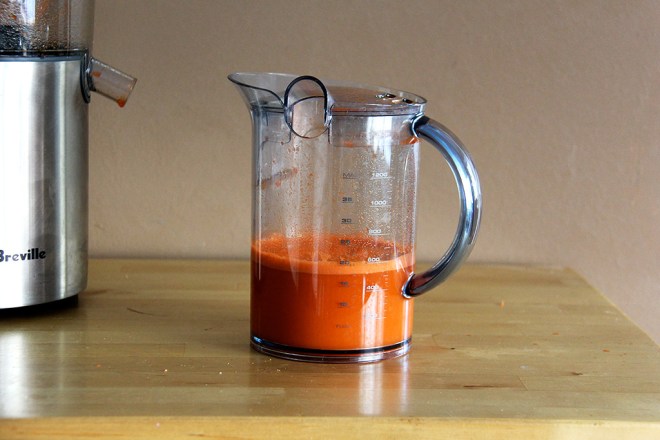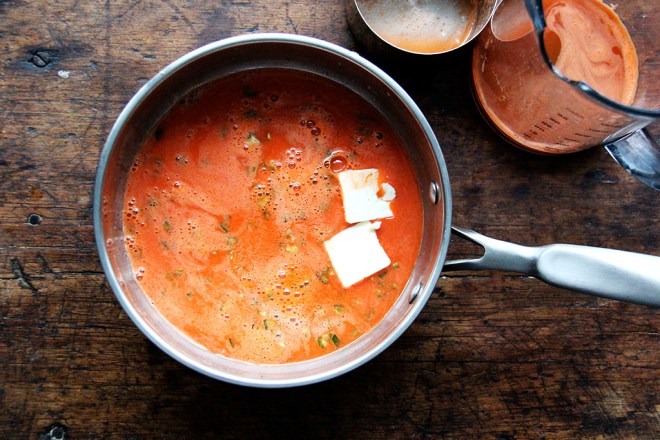I did not need another monstrosity of a gadget cluttering my countertop. I had no interest in a cleanse or in meal replacements. I have always believed in eating vegetables in their mostly recognizable state, raw or simply cooked with minimal seasoning.
But in the weeks leading up to Christmas, I rationalized my way into owning a juicer. In fact, I willed it to happen: I refused to visit my local co-op without ordering the “Sweet Sunset” — a $6 blend of beets, carrots, and apples — and without noting that owning a juicer would quickly pay for itself.
Besides, I would tell myself, thanks to my CSA, I have SO many perfect juicing vegetables on hand — what a great way to use up some of those tired looking beets and carrots. I even pulled out an old “Cook Like a Pro” article from Bon Appétit, which promised that making “the best sauce is as easy as juicing.” Who says juicers are unitaskers?
On and on I went till Santa couldn’t take it anymore and somehow snuck a gargantuan box under the tree. I put the juicer to work straight away and have since been welcoming each morning with some sort of “sweet sunset” concoction, and when I visit my co-op, I, smugly march right on past the juice bar.
Thus far the juicer has exceeded expectations, which I attribute mostly to its employment as broth maker and, in particular, to this Jean-Georges Vongerichten carrot broth recipe. It comes from The Chefs of the Times cookbook, a collection of recipes culled from 23 chefs who offer insight on the inspiration behind each of their recipes.
In the preface to his “Scallops in Carrot Broth” recipe, Vongerichten explains that in response to a sauce-phobic customer base in the 1980s, he began moving away from using stocks for sauces, turning instead to vegetable juices. Wanting something nearly raw, simple, and fresh, he seasoned carrot juice with lemongrass, limes, and chilies — flavors he discovered while working in Bangkok — then finished it off with roughly chopped mint and cilantro.
I followed the recipe to a T the first time around, serving the broth in shallow bowls with pan-seared scallops. The contrast of the brilliant orange against the white of the scallops and the green of the herbs made for a restaurant-worthy presentation, and I made sure to savor it all with a spoon — each mouthful contained both scallop and broth, something Vongerichten insists on. But the broth, with its bright, sharp, spicy flavors evoking many a Southeast Asian soup made me want to cup that bowl with my hands, lift it to my face, and slurp it down like morning cereal milk.
Maybe it’s the chilly weather, but I prefer using this broth in less elegant presentations, with ingredients that better assume the flavor of the broth. Somen noodles and flaky white fish like haddock so nicely absorb the flavor of the lemongrass, lime, and chile. This soup could certainly be made vegetarian, too — tofu and mushrooms would be great additions — but any number of ingredients could work, especially those with sponge-like textures.
Made with few ingredients, this broth takes no time to throw together if you own a juicer. I am by no means trying to convince any of you to buy one, but if you’re curious about using juice as broth, I suggest buying fresh carrot juice from a juice bar or health food market — 1 1/2 cups is all you need.
Choosing and storing your carrots:
- Carrots should feel firm to the touch. Avoid carrots that feel flimsy or that have soft spots or cracks. If you buy carrots with the tops still attached, the greens should look bright and fresh. Remove the greens before storing the carrots — they’ll keep longer when separated from their greens.
- If you have space in your fridge, store carrots in a plastic, perforated, or open bag in your vegetable bin. Avoid storing carrots near apples or pears because the ethylene in these fruits can cause the carrots to spoil. If you don’t have space in your fridge, a cool basement or closet will work, too.
Prepping your carrots:
- The first carrots of the season (those harvested in the spring and summer) do not need to be peeled — just wash them well and proceed with your recipe or eat them raw.
- Late-season carrots (those harvested in fall), whose skin can be bitter, sometimes benefit from being peeled, though they don’t have to be — taste one before peeling. If your carrots are dirty, wash them well before using.
Eating your carrots:
Raw:
- Fresh carrots taste delicious on their own. Serve them with hummus or blue cheese dressing for a simple hors d’oeuvre or snack.
- Shred, julienne, or grate carrots then toss with cabbage and a ginger-miso dressing for a refreshing, vegan slaw.
- Or make a spicy, raw salad with julienned carrots, cayenne, garlic, olive oil, vinegar, and cilantro.
Boiled or steamed:
- Most simply, boil carrots until tender, then dress with butter, salt, and any number of fresh herbs: parsley, dill, chives, thyme, mint, or cilantro. Or, after boiling, toss carrots with harissa, preserved lemon, olive oil, vinegar, and cilantro for a Moroccan salad that tastes better by the day.
Stovetop:
- Make a fast but elegant side dish: Cut carrots into batons, toast cumin and coriander seeds, sauté carrots with the toasted spices and a little butter and oil, then dress with maple syrup and cook until the carrots are fork-tender and caramelized.
- Or, braise sliced carrots on the stovetop with butter, salt, thyme, and water for 15 minutes, then uncover and continue cooking until the liquid has reduced and a syrupy glaze coats the carrots.
Soups and stocks:
- Carrots are a staple in stocks, soups, sauces, and winter braises.
- For a more concentrated flavor in soup, roast carrots before puréeing them with a stock. This creamy-tasting vegetarian, dairy-free version calls for infusing a vegetable broth with ginger and thyme and takes no time to throw together.
- Roast roughly chopped carrots with olive oil, salt, and fresh thyme. (Or combine them with other vegetables — parsnips, sweet potatoes, etc. — if desired.)
- Or, purée roasted carrots with harissa then spread over crostini and top with crème fraîche for a sweet-spicy party snack.
Baked:
- Make the ultimate healthy breakfast muffin with grated carrots, apples, chopped walnuts, raisins, whole-wheat flour, date paste, and soy milk.
- Or, make a super-moist cake spiced with cardamom, layered with cream cheese frosting.
Pickled:
- Carrots, on their own, make great pickles, but when julienned and combined with cucumbers and daikon radish, they make a great addition to any sandwich, báhn mì in particular.
Somen Noodles and Haddock in Lemongrass-Carrot Broth
See the full recipe (and save it and print it) here.
Serves 4
1 1/2 pounds carrots or 1 1/2 cups fresh carrot juice
2 stalks lemongrass
2 tablespoons butter
1 1/2 limes, juiced
1 small chile, such as serrano, minced (if you like heat, leave in some of the seeds)
1 pound flaky white fish, such as haddock
1 teaspoon olive oil
Pinches kosher salt
Small handful cilantro, roughly chopped
1 to 2 bundles somen noodles (about 4 ounces)
Hot sauce such as Sriracha, optional







